Eine Frage der Ähre
Author: Jeffrey D. Allers
Publisher: Pegasus Spiele
Year: 2009
review by

| x |
|
|
|
|
|
|
|
|
|
|
|
|
|
|
|
|
|
|
|
|
|
|
|
|
|
|
|
|
|
|
|
|
|
|
|
|
|
|
|
|
|
|
|
|
|
|
 |
In ‘Eine Frage der Ähre’, the players are confronted with the fact that farm life is not just very romantic, but it's also very hard work. They attempt to plant large fields, and simultaneously save money for new farms and livestock, and all that without the help of any EU subsidies!
|
|
| x |
|
|
|
|
|
|
|
|
|
|
|
|
|
|
|
|
|
|
|
|
|
|
|
|
|
|
|
|
|
|
|
|
|
|
|
|
|
|
|
|
|
|
|
|
|
|
| Luckily, they don't have to stand by helplessly to watch the fields of their competitors grow; it is perfectly allowed to plant new crops on top of somebody else's field. This way, all players try to build a respectable farm, and the most successful player wins. |
|
| x |
|
|
|
|
|
|
|
|
|
|
|
|
|
|
|
|
|
|
|
|
|
|
|
|
|
|
|
|
|
|
|
|
|
|
|
|
|
|
|
|
|
|
|
|
|
|
|
Each player receives three tiles depicting two of five different crops. In a player's turn, he places one of his tiles on the field. This way, larger areas of tiles all depicting the same crop may be formed. For each of the two crops on the tile he just placed, a player decides whether he wants to collect victory points, or farm points. He scores one victory point per tile in the newly formed area, or as many farm points as there are farm symbols depicted on the crop tile (0, 1 or 2). These farm points are scored on a separate farm list, showing five tracks, one for each of the five different crops. At the end of his turn, the player takes a new field tile from the general stock.
|
|
 |
|
| x |
|
|
|
|
|
|
|
|
|
|
|
|
|
|
|
|
|
|
|
|
|
|
|
|
|
|
|
|
|
|
|
|
|
|
|
|
|
|
|
|
|
|
|
|
|
|
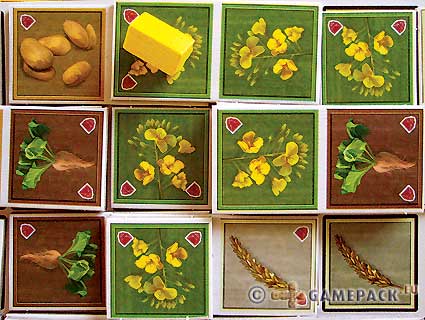 |
|
This all sounds very simple. But wait: there is more! The farm points serve multiple purposes. As soon as a player reaches a certain number of farm points on all five tracks, he immediately places a farm on the field, on a crop tile of his choice. From now on, he scores points for this farm in every turn. The number of victory points depends on the size of the area where he placed his farm. Each player can collect a maximum of two farms.
|
|
| x |
|
|
|
|
|
|
|
|
|
|
|
|
|
|
|
|
|
|
|
|
|
|
|
|
|
|
|
|
|
|
|
|
|
|
|
|
|
|
|
|
|
|
|
|
|
|
|
Additionally, at the end of each track, three animal tokens are placed. When a player reaches the end of a track, he is awarded one of these tokens. The cow, on top, scores the most points; for the second and third runner-up, a pig and a chicken are available.
The game ends as soon as all field tiles have been placed on the board. The victory points for the livestock tokens are added to the scoring track, thereby revealing the victor.
|
|
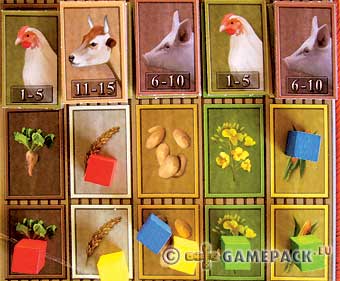 |
|
|
|
|
|
|
|
|
|
|
|
|
|
|
|
|
|
|
|
|
|
|
|
|
|
|
|
|
|
|
|
|
|
|
|
|
|
|
|
|
|
|
|
|
|
|
|
|
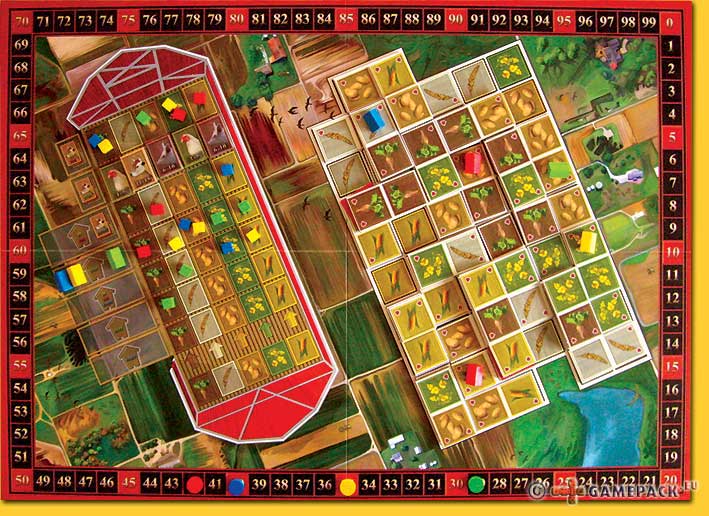 |
| x |
|
|
|
|
|
|
|
|
|
|
|
|
|
|
|
|
|
|
|
|
|
|
|
|
|
|
|
|
|
|
|
|
|
|
|
|
|
|
|
|
|
|
|
|
|
|
| x |
|
|
|
|
|
|
|
|
|
|
|
|
|
|
|
|
|
|
|
|
|
|
|
|
|
|
|
|
|
|
|
|
|
|
|
|
|
|
|
|
|
|
|
|
|
|
| x |
|
|
|
|
|
|
|
|
|
|
|
|
|
|
|
|
|
|
|
|
|
|
|
|
|
|
|
|
|
|
|
|
|
|
|
|
|
|
|
|
|
|
|
|
|
|
 |
|
|
|
|
|
|
|
|
|
|
|
|
|
|
|
|
|
|
|
|
|
|
|
|
|
|
|
|
|
|
|
|
|
|
|
|
|
|
|
|
|
|
|
At first sight, ‘Eine Frage der Ähre’ seems a very simple tile-laying game. It only becomes interesting when the farms enter the game. They give the owner 'free' victory points every single round. An area with a farm on it can not be used to score victory points the regular way, by adding a tile to the area. Therefore, there is no benefit for the opponents to enlarge this area, and as a result they will try to decimate the area as quickly as possible, by placing other tiles on top of it. The owner then has the responsibility to try and glue the pieces back together, or to settle for less and less points every round...
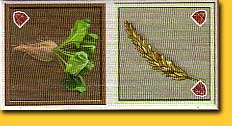
|
|
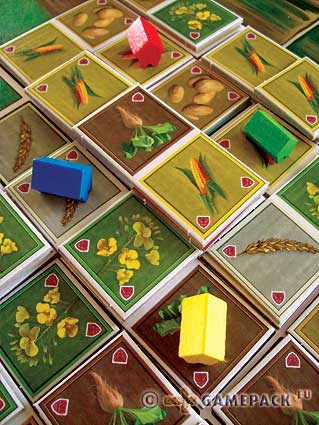 |
|
|
|
|
|
|
|
|
|
|
|
|
|
|
|
|
|
|
|
|
|
|
|
|
|
|
|
|
|
|
|
|
|
|
|
|
|
|
|
|
|
|
|
|
|
|
|
|
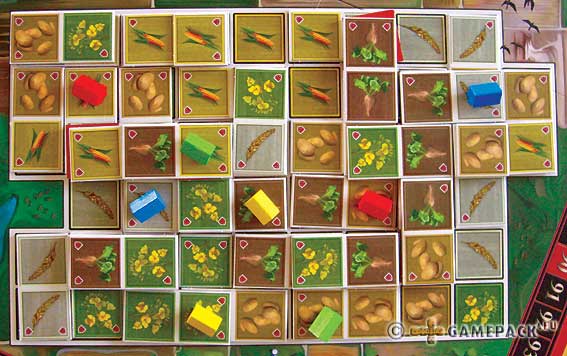 |
|
Placing farms can be very advantageous, but the victory points awarded for livestock are also very profitable. Therefore, the importance of the farm points should not be underestimated! But sometimes it is súch a shame to choose for farm points when one could score a very decent number of direct victory points instead...
|
|
| x |
|
|
|
|
|
|
|
|
|
|
|
|
|
|
|
|
|
|
|
|
|
|
|
|
|
|
|
|
|
|
|
|
|
|
|
|
|
|
|
|
|
|
|
|
|
|
And that is probably the most complicated dilemma one encounters in this game. ‘Eine Frage der Ähre’ is a robust, well-developed game, but because of the high level of simplicity, it will probably not enthral the regular player on a long-term basis. On the other hand, the game will certainly appeal to families with children and to them this game is highly recommended.
© 2009 Barbara van Vugt
Eine Frage der Ähre, Heffrey D. Allers, Pegasus Spiele, 2009 - 2 to 4 players, 8 years and up, 45 - 60 minutes
|
|
  |
|
|
|
|
|
|
|
|
|
|
|
|
|
|
|
|
|
|
|
|
|
|
|
|
|
|
|
|
|
|
|
|
|
|
|
|
|
|
|
|
|
|
  |
|
|
|
|
|
|
|
|
|
|
|
|
|
|
|
|
|
|
|
|
|
|
|
|
|
|
|
|
|
|
|
|
|
|
|
|
|
|
|
|
|
|
  |
...Logo with drop shadow, graduation, outline ànd inline - hello art director! This is a game and 2009, not a supermarket leaflet or the begin of the DTP era! |
|
| x |
|
|
|
|
|
| x |
|
|
|
|
|
|
|
|
|
|
|
|
|
|
|
|
|
|
|
|
|
|
|
|
|
|
|
|
|
|
|
|
|
|
|
|
|
|
|
|
|
|
|
|
|
|
Also read the  |
|
|
|
|
|
|
|
|
|
|
|
|
|
|
|
|
|
|
|
|
|
|
|
|
|
|
|
|
|
|
|
|
|
|
|
|
|
|
|
|
|
|
|
|
|
|
|
|
|
|
 |
|
|
|
|
|
|
|
|
|
|
|
|
|
|
|
|
|
|
|
|
|
|
|
|
|
|
|
|
|
|
|
|
|
|
|
|
|
|
|
|
|
|
 |
|
|
|
|
|
|
|
|
|
|
|
|
|
|
|
|
|
|
|
|
|
|
|
|
|
|
|
|
|
|
|
|
|
|
|
|
|
|
|
|
|
|
| x |
|
|
|
|
|
|
|
|
|
|
|
|
|
|
|
|
|
|
|
|
|
|
|
|
|
|
|
|
|
|
|
|
|
|
|
|
|
|
|
|
|
|
|
|
|
|
 |
|
|
|
|
|
|
|
|
|
|
|
|
|
|
|
|
|
|
|
|
|
|
|
|
|
|
|
|
|
|
|
|
|
|
 |
|
|
|
|
|
|
|
|
|
|
|
|
|
|
|
|
|
|
|
|
|
|
|
|
|
|
|
|
|
|
|
|
|
|
|
|